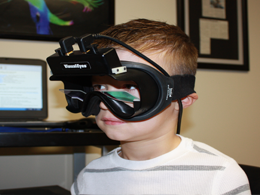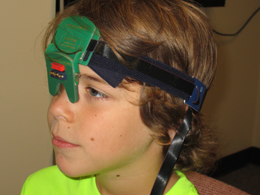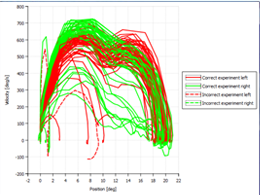The advanced neurological testing procedures listed below allow us to pinpoint brain impairments that may be responsible for your child or teenager’s neuro-developmental concern. Most children 6 years old and over have no problem having these computerized oculomotor tests performed. In fact most think the goggles are pretty neat. Some younger children or those with more advanced autism or sensory issues may not have these tests or others performed. In those cases we rely on the bedside neurologic examination testing.
Video Nystagmography VNG

VNG is a computerized system used in the assessment of the oculomotor system (nervous system control of eye movement) and the function of those areas of your brain controlling these movements.
The VNG test is comfortably performed in our office. We simply place special goggles with an infrared camera on your child or teenager’s head to record and measure their eye movements in both light and dark conditions. Specific areas and pathways of your child’s brain are activated during different types of eye movements. During the test, computer software is recording and graphing their precise eye movements as they follow a visual target with their eyes. By measuring their recorded eye movements and displaying them on the computer screen, we can see how they compare to normal measurements.
Specific areas and pathways of the brain are activated during different types of eye movements. During the test computer software is recording and graphing your precise eye movements as you follow the visual target with your eyes. By measuring your recorded eye movements and displaying them on the computer screen you can see your own eye movements and how they compare to normal measurements.
The following eye movements are measured by VNG:
- Gaze Stability: It is essential that the brain stabilizes the gaze of the eyes for proper focus and attention as well as motor coordination. One of the most common ocular motor deficiencies seen in neuro-developmental cases is poor gaze stability. This can be seen on the VNG tracing.
- Pursuits: Pursuits are slow and steady eye movements that allow you to track a moving object. Good, smooth pursuits are essential to everyday functions but are particularly important in the mechanics of reading. When a patient reads the line of words in a book they are using their pursuit mechanism. The smoothness of the pursuit mechanism is commonly altered in neuro-developmental disorders.
- Saccades: Saccades are fast eye movement used to shift a person’s gaze from one object to another. Saccades are generated by the frontal lobes of the brain. The frontal lobes are important in executive functions such as attention. A child’s saccades can be evaluated to determine their level of frontal lobe development and function. Saccades need to be fast and accurate. Saccades are also used in reading when a person shifts their line of site from one line they are reading to the next. If the saccades are not accurate this can affect a child’s ability to read.
- Optokinetics (OPK): This is an essential eye movement that allows for visual function as the surrounding visual environment passes by. When these are dysfunctional it can indicate poor brain function. Rightward OPK is generated by the right brain and leftward OPK is generated by the left brain. The quality of the OPK response can help us determine what side of the brain is not functioning as well. This brain imbalance is seen in many neuro-developmental disorders
- Vestibular Ocular Reflex: When you child moves their head their eyes should move equally in the opposite direction if this reflex is functioning properly. This reflex is poorly developed in children with neuro-developmental disorders.
The VNG eye movement tracings provide invaluable neurologic information concerning specific areas of your child or teenager’s brain. We are experts at analysing these specific eye movements and determining if they have been developed properly and are functioning properly. We correlate the VNG findings with our other testing and examination procedures to develop a specific therapeutic program for each individual child.
Saccadometry

We also measure your child’s saccades using saccadometry. As described above saccades are quick movements of your eyes that allow you to voluntarily move your eyes quickly from one object to another or to react by moving your eyes to a suddenly appearing target reflexively. Saccades can also be measured using a device called a saccadometer. The saccadometer measures different aspects of the saccades than the VNG measures. The saccadometer is strapped around your child’s head using an elastic headband. Within the unit, there is a laser that projects targets onto the wall that a patient will look at quickly or saccade to. The saccadometer will measure the eye movements at the same time.
Studies have shown saccadic testing to be a very accurate way to detect areas of improper brain development and function. This test cannot be altered voluntarily by the patient because you cannot consciously control the speed of your eye movement during each saccade; your eyes move as fast as they can. The purpose of your saccadic eye movement is to aim the part of your eye with the best vision (fovea) at the thing you want to see most, and then hold your eye there as you examine it.
Saccades are the only human physiological function that use every area of the brain. It is for this reason that we can evaluate a person’s saccades to determine what areas of the brain are not functioning at par.
Some of the brain areas used in controlling saccades involves three main brain regions: the frontal eye fields, the parietal eye fields, and the supplementary eye fields; and several subcortical areas in the basal ganglia, thalamus and brainstem. These areas are commonly not developed as well as they should be in children with neurodevelopmental disorders.
Saccadometry very precisely measures these aspects of saccades:
- Latency: This is the reaction time taken for the saccade to fire or activate after a new stimulus or target is presented. A normal reaction time should be less than 200ms.
- Velocity: The speed of a saccade is highly related to health of areas in the brain stem commonly affected in neurological disorders.
 Accuracy: The ability to make the eyes stop and land directly on the target they are saccading to or looking toward is essential to a person functioning in their environment accurately. If the saccade overshoots or undershoots the target it may indicate that the cerebellum or the area of the brain that makes the environmental grid may not be functioning so well.
Accuracy: The ability to make the eyes stop and land directly on the target they are saccading to or looking toward is essential to a person functioning in their environment accurately. If the saccade overshoots or undershoots the target it may indicate that the cerebellum or the area of the brain that makes the environmental grid may not be functioning so well.
The saccadometer computerized graph shows leftward saccades that are generated by the right brain hemisphere as red and the rightward saccades that are generated by the left brain as green. This can be very useful in determining what side of the brain is out of sync.
Interactive Metronome (IM) diagnostic testing

We use interactive metronome long and short form diagnostic testing to assess a child’s focus, timing and ability to coordinate visual and auditory stimulation while doing a gross motor skill.
IM is an assessment and treatment tool used by therapists and other professionals who work with pediatric and adult patients with neurological conditions that affect cognitive and motor functioning. IM provides an objective method for measuring deficits and for tracking improvement.
IM is an evidence-based and engaging therapeutic modality that improves cognitive and motor skills. The design of the program ensures that patients recognize progress as it occurs, increasing their motivation toward therapy and their ultimate recovery.
IM is used to improve:
- Attention
- Coordination
- Language processing
- Reading and math fluency
- Control of impulsivity/aggression


